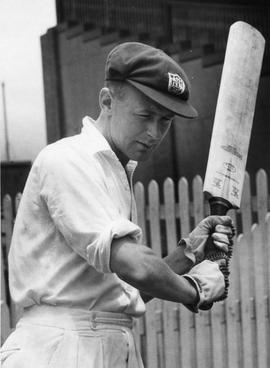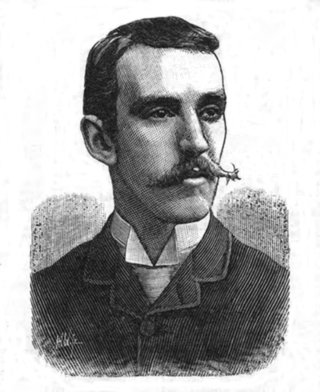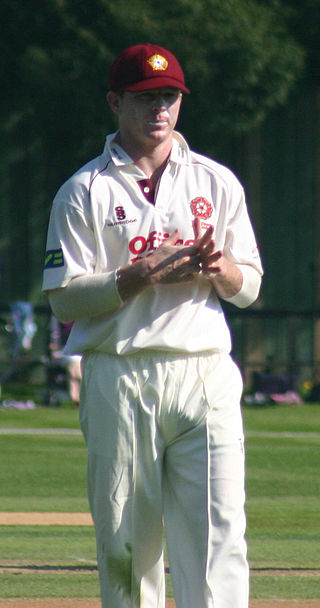Related Research Articles

Samuel Moses James Woods was an Australian sportsman who represented both Australia and England at Test cricket, and appeared thirteen times for England at rugby union, including five times as captain. He also played at county level in England at both soccer and hockey. At cricket—his primary sport—he played over four hundred first-class matches in a twenty-four-year career. The majority of these matches were for his county side, Somerset, whom he captained from 1894 to 1906. A. A. Thomson described him thus: "Sammy ... radiated such elemental force in hard hitting, fast bowling and electrical fielding that he might have been the forerunner of Sir Learie Constantine."

Ian David Craig was an Australian cricketer who represented the Australian national team in 11 Tests between 1953 and 1958. A right-handed batsman, Craig holds the records for being the youngest Australian to make a first-class double century, appear in a Test match, and captain his country in a Test match. Burdened by the public expectation of being the "next Bradman", Craig's career did not fulfil its early promise. In 1957, he was appointed Australian captain, leading a young team as part of a regeneration plan following the decline of the national team in the mid-1950s, but a loss of form and illness forced him out of the team after one season. Craig made a comeback, but work commitments forced him to retire from first-class cricket at only 26 years of age.

Arthur Robert Morris was an Australian cricketer who played 46 Test matches between 1946 and 1955. An opener, Morris is regarded as one of Australia's greatest left-handed batsmen. He is best known for his key role in Don Bradman's Invincibles side, which made an undefeated tour of England in 1948. He was the leading scorer in the Tests on the tour, with three centuries. His efforts in the Fourth Test at Headingley helped Australia to reach a world record victory target of 404 on the final day. Morris was named in the Australian Cricket Board's Team of the Century in 2000 and was inducted into the Australian Cricket Hall of Fame in 2001.

Henry James Herbert "Tup" Scott was an Australian cricketer who played first-class cricket for Victoria and Test cricket for Australia. He acquired his nickname during a cricket tour of England in 1884 from his love of London sightseeing tours which cost two pence or "tuppence".

Ronald Arthur Saggers was an Australian cricketer who played for New South Wales. He played briefly for the Australian team, playing six Tests between 1948 and 1950. In his Test cricket career he made 24 dismissals and scored 30 runs at an average of 10.00.

John William Trumble was an Australian cricketer who played in seven Tests between 1885 and 1886. He was the older brother of the Test cricketer Hugh Trumble and the senior Australian public servant Thomas Trumble.

Otto Ernest Nothling was a rugby union player who represented Australia, as well as an Australian cricketer who played in one Test in 1928. He is one of only two Australian rugby and cricket dual internationals, the other being Johnny Taylor. He became a dermatologist.

Ernest Raymond Herbert Toshack was an Australian cricketer who played in 12 Tests from 1946 to 1948. A left arm medium paced bowler known for his accuracy and stamina in the application of leg theory, Toshack was a member of Don Bradman's "Invincibles" that toured England in 1948 without being defeated. Toshack reinforced the Australian new ball attack of Ray Lindwall and Keith Miller.

Clement Arthur Milton was an English cricketer and footballer. He played County cricket for Gloucestershire from 1948 to 1974, playing six Test matches for England in 1958 and 1959. He also played domestic football for Arsenal between 1951 and 1955, and then for a brief period for Bristol City. He played one match for England in 1951, against Austria at Wembley. He was the last man, and the last survivor, of the twelve people to have played at the highest international level for both England's football and cricket teams.

Christopher John Llewellyn Rogers is a former Australian cricketer who played for the Australian national team. Rogers is a left-handed opening batsman. He spent ten years playing for Western Australia, before moving to play for Victoria in 2008. He played county cricket in England for ten years representing five first-class teams: Derbyshire, Leicestershire, Northamptonshire, Middlesex and Somerset. Rogers holds the record for most half centuries in consecutive innings.
The New Zealand national cricket team toured Australia in the 1993–94 season to play in three test matches against Australia before playing in a tri-series with South Africa. The tour began on October 19, in Perth, Western Australia, against an Australian Chairman XI as they played in five warm-up matches before the test matches in Perth, Hobart and Brisbane. New Zealand were captained by Martin Crowe while the Australians were captain by Allan Border.

Phillip Joel Hughes was an Australian Test and One Day International (ODI) cricketer who played domestic cricket for South Australia and Worcestershire. He was a left-handed opening batsman who played for two seasons with New South Wales before making his Test debut in 2009 at the age of 20. He made his One Day International Debut in 2013.
Simon John Halliday is a former English rugby union international. He also played nine first-class cricket matches. He was educated at Downside School, Somerset and St Benet's Hall, Oxford.

Basil Holmes 'Jika' Travers,, was an Australian sportsman and educator who played in the England national rugby union team and played first-class cricket with Oxford University.
Edward Keith Scott was an English sportsman who played first-class cricket and represented the England national rugby union team.
Grahame Wilshaw Parker was an English sportsman who played first-class cricket for Gloucestershire and represented the England national rugby union team.

James Michael Vince is an English cricketer who is the captain for Hampshire County Cricket Club and plays for the England cricket team. Vince was part of the England squad that won the 2019 Cricket World Cup. He is a right-handed middle-order batter who is also a right-arm medium pace bowler. He made his international debut for England in May 2015.
Hugh James Orr was an Australian-born Scottish first-class cricketer, rugby union player and Royal Navy officer.
John Oswald "Ossie" Newton-Thompson was a South African sportsman and politician. He played international rugby union for England and was also a first-class cricketer. From 1961 until his death in 1974, Newton-Thompson was a member of the South African parliament.
Edgar William Elliot was an English cricketer and rugby union player. In cricket, Elliot was a right-handed batsman who bowled right-arm medium fast, while in rugby union he played on the wing. He was born in Roker, County Durham and died in Vancouver, British Columbia, Canada on 23 March 1931.
References
- 1 2 3 4 "Philip John Crowe". www.classicwallabies.com.au. Retrieved 14 July 2020.
- ↑ "Phil Crowe - Test matches". ESPNscrum. Retrieved 14 July 2020.
- ↑ "First-Class Matches played by Philip Crowe" . CricketArchive. Retrieved 14 July 2020.
- ↑ "Oxford University v Gloucestershire, 1982" . CricketArchive. Retrieved 14 July 2020.
- ↑ "Professor Phil Crowe". www.powcs.med.unsw.edu.au. Retrieved 14 July 2020.